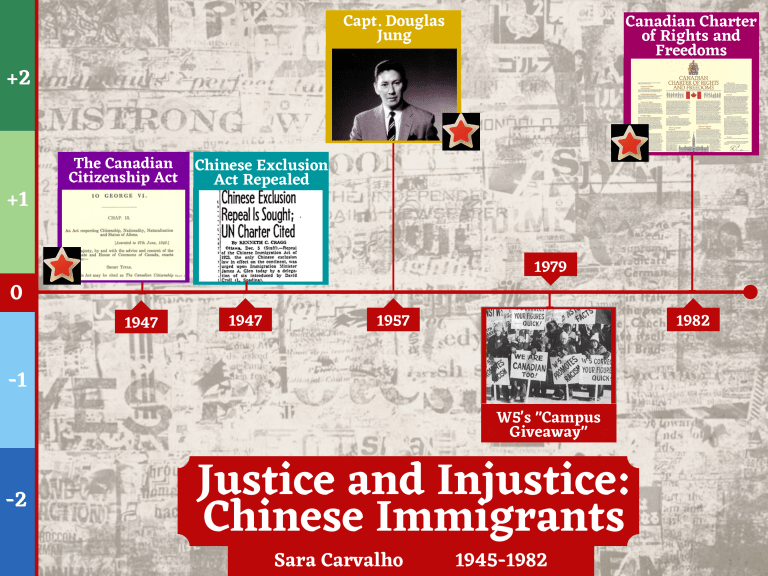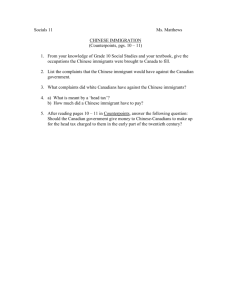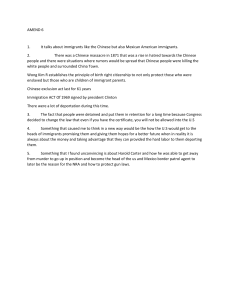Chinese Immigration to Canada: A Timeline of Justice & Injustice
advertisement

Capt. Douglas Jung Canadian Charter of Rights and Freedoms +2 +1 0 The Canadian Citizenship Act Chinese Exclusion Act Repealed 1979 1947 1947 1957 1982 -1 W5's "Campus Giveaway" -2 Justice and Injustice: Chinese Immigrants Sara Carvalho 1945-1982 TURNING POINT The Canadian Citizenship Act (1947) Who: Canadian Government, Chinese Immigrants, Chinese Canadians What: Canadian citizenship is created. Chinese residents of Canada are allowed to obtain citizenship. They are given the same rights, power and privileges as natural-born citizens such as voting. Where: Canada When: January 1st, 1947 Why: The creation of the Canadian citizenship Act eased racial and ethnic tensions in Canada and create a sense of unity among its increasingly diverse population. For years, Chinese residents in Canada were not seen as equal to white Canadians. They were barred from voting and pursuing many occupations. The creation of the Canadian Citizenship Act not only established citizenship but also granted every Canadian citizen the same rights, privileges and power. In order to attain a citizenship, Chinese residents had to prove they were of good character, possessed adequate knowledge of English or French and had resided in Canada for more than 5 years. This Act allowed more Chinese Canadians to prosper in jobs they were once prohibited to do, such as pharmacists, lawyers and accountants. This also helped the Canadian economy because more citizens could open prosperous businesses and contribute to Canada's economy. Chinese Canadians were also given the right to vote in both federal and provincial elections. This changed the political climate in Canada because it normalized every Canadian having a say in important decisions that affect lives, instead of just white Canadians. I rated this event +1 on my timeline instead of a +2 because the Canadian Citizenship Act only extended citizenship to naturalized residents who arrived before the enactment of the legislature. Therefore, Chinese immigrants who arrived after the Act was put in place would be ineligible to receive citizenship. The Chinese Exclusion Act Repealed (1947) Who: Canadian Government, Chinese Canadians, Chinese immigrants. What: The Chinese Exclusion Act was repealed which allowed spouses and children of Canadian citizens to immigrate from China to Canada. Where: Canada When: May 14th, 1947 Why: Canada joined the United Nations and signed the Charter of Human Rights, which the Chinese Exclusion Act was in violation of. Politicians, labour unions, church leaders and war veterans also demanded that the Canadian government repeal the Act. Visible minorities, like people of Chinese descent, were blamed for the economic depression after Ⅰ WW so the Canadian government decided to ban almost all immigration from China. Chinese immigrants were barred from entering Canada for 24 years. In 1947, the Chinese Exclusion Act was repealed by the government, which allowed the immediate family of Chinese Canadians to immigrate to Canada. Chinese families were reunited in Canada, which changed the social climate because before, Canada's Chinese population was primarily men who'd faced many hardships because they dreamt of bringing their families to Canada but were unable too. I rated this event a +1 because it did loosen restrictions on Chinese immigrants by allowing spouses and children of Chinese Canadians into Canada, but it still prohibited Chinese immigrants without family already in Canada to immigrate. In 1947, when the Act was repealed, only 8% of Chinese-born residents in Canada were naturalized citizens, therefore, a very small number of families could be reunited in Canada. Although the Chinese Exclusion Act being repealed was a positive event, it did not fix the racist immigration barriers that Chinese immigrants faced while trying to enter Canada. TURNING POINT Captain Douglas Jung (1957) Who: Douglas Jung What: The first Canadian of Chinese descent to be a Member of Parliament. Where: Vancouver, British Columbia When: June 10th, 1957 Why: He was a lawyer who represented Vancouver Centre in Parliament. Captain Douglas Jung was a Chinese Canadian M.P., Special Operations Executive secret agent, representative of Canada in the United Nations, politician, military serviceman and lawyer. For much of his life, Jung was segregated and discriminated against because of his Chinese heritage. He was not deemed a Canadian citizen and therefore not given the same rights as Canadians until 1947. In 1957, he became the first Chinese Canadian M.P. representing Vancouver Centre. Jung urged for Canada to serve as a bridge to the Pacific Rim countries, including China which caused positive political change. Captain Douglas Jung was an innovative M.P. He established many programs to help Chinese immigrants in Canada, such as the Amnesty program. It permitted thousands of undocumented immigrants to regularize their status with the Immigration Department and allowed them to apply for the admittance of their families to Canada. Douglas acknowledged the lack of recognition that Chinese Canadian war veterans received after WW and made amends by organizing visits to their ancestral homelands. He was an advocate for diversity, inclusion, and positive policy changes that advance the belonging, wellness and independence of people on their Canadian journey. Using his political power, Douglas Jung not only improved the lives of Chinese Canadians and immigrants, but he also normalized Chinese Canadians being in positions of power, attending post-secondary education and being prosperous. Despite the hardships Captain Douglas Jung faced at the hands of the Canadian Government, he still fought for Canada both overseas and on the home-front. I rated this event a 2+ because Douglas Jung bettered the lives of thousands of Canadians and did not cause any harm to any other people. Ⅱ W5's "Campus Giveaway" Who: W5 television program, Helen Hutchinson, Chinese Canadian students, Chinese Canadians. What: W5 released an investigative segment stating that "foreign students" (Chinese Canadians) were taking the places of white Canadians in university programs. Where: Canada When: September 30th, 1979 Why: W5 created the segment after a white Canadian, Barbara Allan, was rejected from the University of Toronto supposedly because Chinese Canadian students took her spot. W5 was a popular television network that developed a great reputation for its investigative journalism and cast of prominent hosts. In 1979, it aired a racist segment in which host Helen Hutchinson claimed that universities in Canada were being overrun by "foreign students."However, most of the students were Chinese Canadians. This event caused outrage and distress among Chinese Canadian students because they were still carving their place in the new multicultural framework of Canada. After the segment aired, many advocates joined together to form networks within the Chinese Canadian community to gain support to launch a national anti-W5 movement. After months of protests, CTV issued an apology for the segment. The network of activists capitalized upon their political momentum and created the Chinese Canadian National Council for Equality (CCNCE). The CCNCE provided a national umbrella organization that could defend the rights of Chinese Canadians. The W5 segment changed the political and social climate within Chinese Canadian communities because it united many residents to fight for fair treatment. I rated this event a -1 because W5's segment saddenned and offended many Chinese Canadians. They were trying to get an education so they could prosper in Canada and some Canadians tried to strip them of their dreams. It was a moment of realization that even though they were citizens of Canada and were entitled to the same rights, their lives were bound to be filled with hardship because some white Canadians would never see them as equal. Moreover, the segment had some positive effects because it resulted in the creation of the CCNCE and united many Chinese Canadians in their communities. TURNING POINT Canadian Charter of Rights and Freedoms (1982) Who: Canadian government, Canadian citizens, Immigrants/newcomers to Canada. What: The Canadian Charter of Rights and Freedoms outlines the rights and freedoms that Canadians believe are necessary in a free and democratic society. Where: Canada When: April 17, 1982 Why: The Charter was put in place to recognize and enforce the rights of minority and disadvantaged groups. Before the Canadian Charter of Rights and Freedoms was created, Chinese residents and Chinese Canadians faced many challenges, including racist behaviour from employers, media and the Canadian Government. The acts of racism often went unnoticed, as there was no legislation in place to punish those who participated. Many people of Chinese descent suffered from terrible mental health and doubted their worthiness of being successful in Canada due to the racist abuse. Section 15 of the Canadian Charter of Rights and Freedoms ensures that the Canadian Government does not discriminate based on race, religion, national origin, colour, sex or age in its laws or programs. This prevented any more discriminatory legislation against Chinese Canadians, like the Chinese Exclusion Act. It ensured that Chinese Canadians could open businesses, build communities and be prosperous in Canada, while still being able to practice their religion and celebrate their Chinese culture. The changed Canada's identity to what it is today—a cultural mosaic that celebrates the diverse cultures of Canadian citizens. I rated this event a +2 because it ensured that Chinese Canadians were able to flourish and caused a positive change in the social climate of Canada because all races became equal under the law. This event had little to no cons. References An Act Respecting Citizenship, Nationality, Naturalization and Status of Aliens. 1946. Statutes of Canada, Library and Archives Canada, 1946. Canadian Charter of Rights and Freedoms. April 17, 1982. Department of Secretary of State, Canada. Chan, Arlene. "Chinese Immigration Act." The Canadian Encyclopedia. March 7, 2017. Accessed July 23, 2021. https://www.thecanadianencyclopedia.ca/en/article/chinese-immigration-act. Chinese-Canadians Protested a W5 Segment Titled "Campus Giveaway". January 1980. Council of Chinese Canadians in Ontario., Ontario. Chinese Exclusion Repeal Is Sought: UN Charter Cited. December 6, 1946. Globe and Mail. Chong, W. "Biography of Captain Douglas Jung SOA." Burma Star Memorial Fund. July 01, 2019. Accessed July 23, 2021. https://burmastarmemorial.org/archive/stories/1405898-biography-of-captain-douglas-jung-soa. Douglas Jung. 1957. Chinese Canadian Museum, British Columbia. Gagnon, Erica. "Canadian Citizenship Act, 1947." Canadian Museum of Immigration at Pier 21. Accessed July 22, 2021. https://pier21.ca/research/immigration- history/canadian-citizenship-act-1947. "Guide to the Canadian Charter of Rights and Freedoms." Canada.ca. June 08, 2020. Accessed July 23, 2021. https://www.canada.ca/en/canadian-heritage/services/how-rights-protected/guide-canadian-charter-rights-freedoms.html#a2f. Leong, Patrick Wen Rui. "Coded Racism and Community Resistance in the Anti-W5 Movement." Open Collections. May 05, 2021. Accessed July 23, 2021. https://open.library.ubc.ca/cIRcle/collections/undergraduateresearch/52966/items/1.0397411. "W5 Strike out." York University Libraries. Accessed July 23, 2021. https://archives.library.yorku.ca/exhibits/show/pushingbuttons/social-activism/w5-strike-out.





